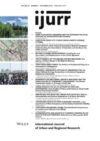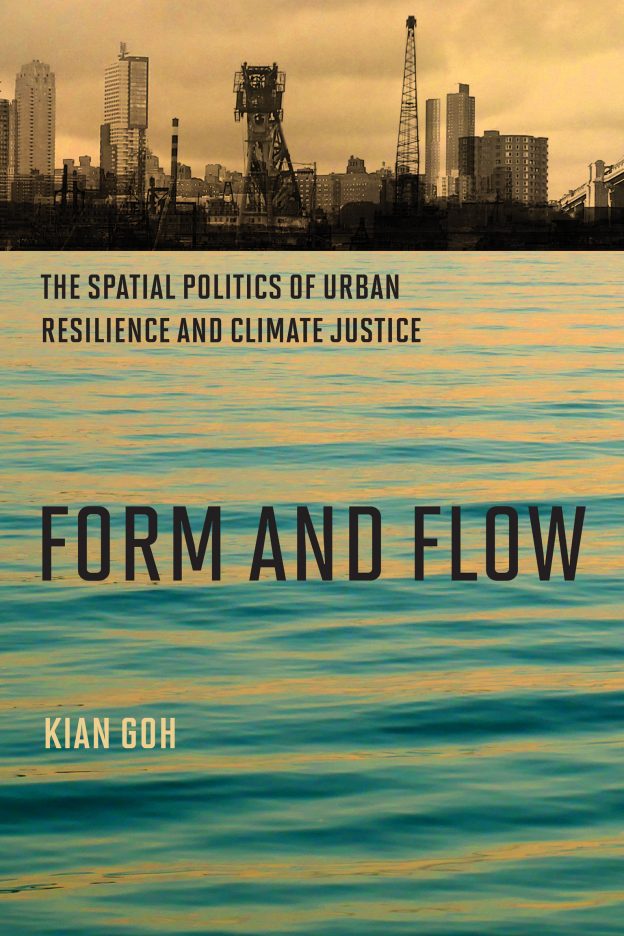‘How are contesting visions of urban futures produced and how do they attain power?’ (p. 3). This is the guiding question behind the new book by Kian Goh, architect and professor of urban planning at UCLA. To contextualize the argument, Goh explains how urban coastal areas globally face alarming risks of flooding due to climate change. She also shows how suffering from the impact of climate change is experienced differently across spatially patterned lines of class, race and housing tenure—the products of inequitable urban development trajectories. Responses to flooding are rife with inequality as well. Focusing on Jakarta, New York and Rotterdam, Goh examines how globally circulating ideas and capital combine with situated sociopolitical, economic and ecological processes to produce official designs for flood protection projects, and how social movements from below contest these official designs with their own counterplans.
What emerges from Goh’s examination is the theoretical construction of a political ecology of design, put to work through an empirical portrait of adaptation in three cities. For social scientists, Form and Flow succeeds in conceptualizing design as a generative object of analysis in climate social theory. For designers and architects, Goh’s exposition of the political economy of design is a necessary corrective to the profession’s neglect of the role of power and social difference in the production of urban space.
In New York, Superstorm Sandy pummeled the coast in 2012, leaving over forty dead, costing billions in economic damage, and rendering thousands of residents in low-income waterfront neighborhoods without power or hot water. In response, the federal government experimented with a design competition, Rebuild by Design, which assembled dozens of government agencies, research groups, international consultants and community stakeholders to design resilient waterfront urban space across the region. Yet the neighborhood groups responded differently to Sandy. In the Lower East Side and Red Hook, two low-income neighborhoods with a high concentration of public housing, activists drew on long-term social networks and local community spaces to help residents directly and to assist them in planning for the next storm. As part of her analysis, Goh explores if and when the activities of local groups influenced official plans—in New York, she argues, movements from below were relatively successful in achieving influence, although they met with limitations and exclusion at times.
In Jakarta, disastrous floods over several decades compelled the government to act. In partnership with a Dutch consulting firm, officials identified that the city was sinking due to dramatic land subsidence. In response, a collection of Dutch firms and the Indonesian government proposed the Giant Seawall Plan, a coastal protection project of staggering scale and cost. Shaped like a ‘Great Garuda’, the legendary bird-like creature on Indonesia’s coat of arms, the project combines seawalls with giant retention lakes and plans for waterfront economic development. However, the plan depends on efficient drainage from the city’s numerous canals, where thousands of poor households are settled in kampungs—dense, often informal low-rise ‘villages’.
In Goh’s account, activists and researchers used design to envision different ways of living in the context of a history of violent evictions and the displacement entailed by the Great Garuda plan. Collaborating with kampung residents, different organizations engaged in ‘design activism’ activities, which in riverine Jakarta involved developing new typologies of permanent housing for people living in kampungs. While the book’s object of analysis is the design plans, in both Jakarta and New York Goh acknowledges the limits of counter-design activities being able in themselves to transform local and global power configurations.
What links these two cities, beyond the common perils of a heated planet and histories of socio-spatial marginalization? Goh finds answers in Rotterdam, a port city in the Netherlands. The Dutch, living in a delta country which lies partly below sea level, proclaim to have water management embedded in their culture and public institutions. The Dutch have also recognized an opportunity to brand themselves as experts on flood control. Reacting to global climate change and the 2008 financial crisis, which slowed business at home, flood technocrats now deploy their expertise abroad. Rotterdam in particular, as leader of the Connecting Delta Cities network, acts as a fulcrum for knowledge about water. And as host to numerous flood-related firms, locals can also benefit by selling their flood-related expertise as a mobile and useful commodity to locales as distinct as Jakarta and New York.
The book closes with a number of possibilities for ‘insurgent urban landscapes’ (p. 177). Urban ecologies are contested, multi-scalar and embedded in historical, cultural and social relationships, the conclusion contends. The pursuit of just and equitable design interventions, then, would benefit from attending to the relationship between physical climate impacts, situated sociocultural practices, and political contestations, as well as globalized processes of economic change. These are refreshing challenges for designers to take up.
After finishing Form and Flow, readers might ask themselves two questions. First, are there cases of multiple social movements in the same city producing and contesting multiple and conflicting counterplans? In my own fieldwork in the Lower East Side I have observed how social movements contest counterplans between themselves, informed by their own distinct and situated political struggles within the same city, and it would be fascinating to read more about how this might complicate the story of plans and counterplans. Second, in Goh’s account it is the state—often co-opted by capitalist urban development interests—that creates dominant plans that can reproduce social inequality. Does Goh see the potential for a democratic state in the US, Indonesia or the Netherlands to shed the capture by capital and embrace the influence of social movements from below? How could the adoption of a policy framework such as the Green New Deal, for example, bolster the state’s potential to produce just and equitable outcomes?
Thanks to Goh’s ability to thread together theoretical arguments with an ambitious empirical outlook, the book will find a wide and diverse audience among social scientists, designers and planning practitioners. As it becomes increasingly clear that climate change and social inequality are major contemporary crises, Form and Flow offers a timely contribution to the critical scholarship of cities writ large.
Malcolm Araos, is a PhD student in Sociology at New York University researching the sociology of climate change.
Kian Goh. Form and Flow: The Spatial Politics of Urban Resilience and Climate Justice. Cambridge, MA: MIT Press. © 2021. Cover used with permission of MIT Press.
Views expressed in this section are independent and do not represent the opinion of the editors.

